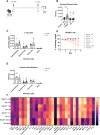Cell-intrinsic regulation of phagocyte function by interferon lambda during pulmonary viral, bacterial super-infection
- PMID: 39178311
- PMCID: PMC11376568
- DOI: 10.1371/journal.ppat.1012498
Cell-intrinsic regulation of phagocyte function by interferon lambda during pulmonary viral, bacterial super-infection
Abstract
Influenza infections result in a significant number of severe illnesses annually, many of which are complicated by secondary bacterial super-infection. Primary influenza infection has been shown to increase susceptibility to secondary methicillin-resistant Staphylococcus aureus (MRSA) infection by altering the host immune response, leading to significant immunopathology. Type III interferons (IFNs), or IFNλs, have gained traction as potential antiviral therapeutics due to their restriction of viral replication without damaging inflammation. The role of IFNλ in regulating epithelial biology in super-infection has recently been established; however, the impact of IFNλ on immune cells is less defined. In this study, we infected wild-type and IFNLR1-/- mice with influenza A/PR/8/34 followed by S. aureus USA300. We demonstrated that global IFNLR1-/- mice have enhanced bacterial clearance through increased uptake by phagocytes, which was shown to be cell-intrinsic specifically in myeloid cells in mixed bone marrow chimeras. We also showed that depletion of IFNLR1 on CX3CR1 expressing myeloid immune cells, but not neutrophils, was sufficient to significantly reduce bacterial burden compared to mice with intact IFNLR1. These findings provide insight into how IFNλ in an influenza-infected lung impedes bacterial clearance during super-infection and show a direct cell intrinsic role for IFNλ signaling on myeloid cells.
Copyright: © 2024 Antos et al. This is an open access article distributed under the terms of the Creative Commons Attribution License, which permits unrestricted use, distribution, and reproduction in any medium, provided the original author and source are credited.
Conflict of interest statement
The authors have declared that no competing interests exist.
Figures








References
-
- Galani IE, Triantafyllia V, Eleminiadou EE, Koltsida O, Stavropoulos A, Manioudaki M, et al. Interferon-λ Mediates Non-redundant Front-Line Antiviral Protection against Influenza Virus Infection without Compromising Host Fitness. Immunity. 2017;46: 875–890.e6. doi: 10.1016/j.immuni.2017.04.025 - DOI - PubMed
-
- Crotta S, Davidson S, Mahlakoiv T, Desmet CJ, Buckwalter MR, Albert ML, et al. Type I and Type III Interferons Drive Redundant Amplification Loops to Induce a Transcriptional Signature in Influenza-Infected Airway Epithelia. PLoS Pathog. 2013;9. doi: 10.1371/journal.ppat.1003773 - DOI - PMC - PubMed
MeSH terms
Substances
Grants and funding
LinkOut - more resources
Full Text Sources
Molecular Biology Databases
Research Materials

